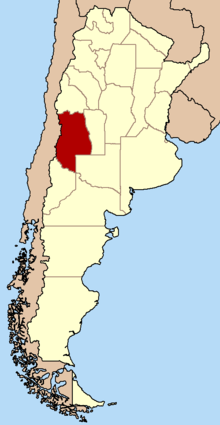- Mendoza wine
-
For other uses, see Mendoza (disambiguation).
The Mendoza Province is one of Argentina's most important wine regions, accounting for nearly two-thirds of the country's entire wine production. Located in the eastern foothills of the Andes, in the shadow of Mount Aconcagua, vineyards are planted at the some of the highest altitudes in the world with the average site located 1,970–3,610 feet (600–1,100 meters) above sea level. The principal wine producing areas fall into two main departments-Maipú and Luján which includes Argentina's first delineated appellation established in 1993 in Luján de Cuyo. The pink-skinned grapes of Criolla Grande and Cereza account for more than a quarter of all plantings but Malbec is the regions most important planting followed closely by Cabernet Sauvignon, Tempranillo and Chardonnay.[1] Mendoza is considered the heart of the winemaking industry in Argentina with the vast majority of large wineries located in the provincial capital of Mendoza.[2][3]
Contents
Climate and geography
Located in the far western expanse of Argentina, the Mendoza wine region is flanked by the long chain of the Andes Mountain which separates it from the many wine centers of Chile with the capital of Santiago only a 50-minute airplane trip from the capital of Mendoza,Argentina. Unlike the nearby maritime influenced wine regions of Chile, Mendoza has a continental climate and semi-arid desert conditions. The region experiences 4 distinct seasons with no extremes in temperatures that provides a relatively uneventful annual growth cycle for grapevines--especially winter dormancy. Rainfall in the region averages around 8 inches (200 millimeters) a year, making irrigation a necessity. Spring time frost is a rare occurrence with the main viticultural concern being summertime hail known locally as La Piedra.[1]
The soil of the Mendoza wine region is primarily alluvial composed of loose sand over clay. Mountain rivers, including the Desaguadero, Mendoza, Tunuyán, Diamante and the Atuel Rivers, provide ample water supplies from melted glaciers in the Andes. Nearly 17,000 boreholes scattered throughout the region provide the equivalent of an additional two rivers' worth of water flow to the area. A system of irrigation channels, canals and reservoirs (some dating to the 16th century) help sustain viticulture in this semi-arid desert region.[1]
Wine producing areas
As of 2008, the Mendoza region contained more than 356,000 acres (144,000 hectares) of planted vineyards-producing nearly two-thirds of the entire Argentine wine production.[2] The principal wine producing areas fall into two main departments – Maipú and Luján, which includes Argentina's first delineated appellation established in 1993 in Luján de Cuyo. With vineyards planted at altitudes between 2,640–3,630 feet (800–1,100 meters), the Luján de Cuyo region is known particular for its Malbec which seems to thrive in this region as a mean annual temperature of 58°F (15°C). Historically the San Rafael region to the south and San Martín region to the east of the city of Mendoza were important centers for wine production. San Rafael was also awarded DOC status in 1993.[4] However the switch to premium wine production of international varieties has diminished their importance. One area of emerging importance in the Mendoza wine region is the Valle de Uco which includes the Tupungato Department featuring vineyards planted nearly 4000 feet (1,200 meters) above sea levels and is emerging as a source for premium quality white wine varietals such as Chardonnay.[1]
In the Luján department, areas that may appear on wine labels include the towns of Anchoris, Agrelo, Carrodilla, Chacras de Coria, Las Compuertas, Mayor Drummond, Perdriel, Tres Esquinas, Ugarteche and Vistalba. In the Maipú department, areas that may appear on wine labels include the towns of Maipú, Coquimbito, Cruz de Piedra, Las Barrancas, Lunlunta and Russell.[1]
Argentina’s most highly rated Malbec wines originate from Mendoza’s high altitude wine regions of Lujan de Cuyo and the Uco Valley. These Districts are located in the foothills of the Andes mountains between 2,800 and 5,000 feet elevation. [5] [6] [7] [8]
Grape varieties
The pink-skinned varieties of Cereza and Criolla Grande have historically formed the backbone of the Mendoza wine industry and today still account for around a quarter of all vineyard plantings. Used primarily for inexpensive jug wines and grape concentrate, their importance has steadily declined as the Mendoza region focuses more on the export of premium wine varietals. Malbec has emerged as the most important variety followed, in planted acreage, by Tempranillo, Cabernet Sauvignon and Chardonnay.[1]
See also
- Bodega Catena Zapata
- Sir Edmund James Palmer Norton
- Trapiche (winery)
References
- ^ a b c d e f J. Robinson (ed.) "The Oxford Companion to Wine", third edition, pp. 29–33, Oxford University Press, 2006 ISBN 0198609906
- ^ a b A. Domine (ed.) Wine, pp. 840–844, Ullmann Publishing, 2008 ISBN 9783833146114
- ^ J. Jimena "Sipping and celebrating in Mendoza" Globe and Mail, Jan 17th 2004
- ^ V. Lombardi (author) International Sommelier Guild; December 2002
- ^ Catena, Laura (September 2010). Vino Argentino, An Insiders Guide to the Wines and Wine Country of Argentina.. Chronicle Books. ISBN 978-0811873307.
- ^ Rolland, Michel (January 2006). Wines of Argentina.. Mirroll. ISBN 978-9872092634.
- ^ WINE TOURS: Argentina - Mendoza, "Fly Fishing Patagonia"
- ^ Wine Tip: Malbec Madness, "Wine Spectator", April 12, 2010
External links
Categories:- Argentine wine
- Mendoza Province
- Wine regions of Argentina
Wikimedia Foundation. 2010.


